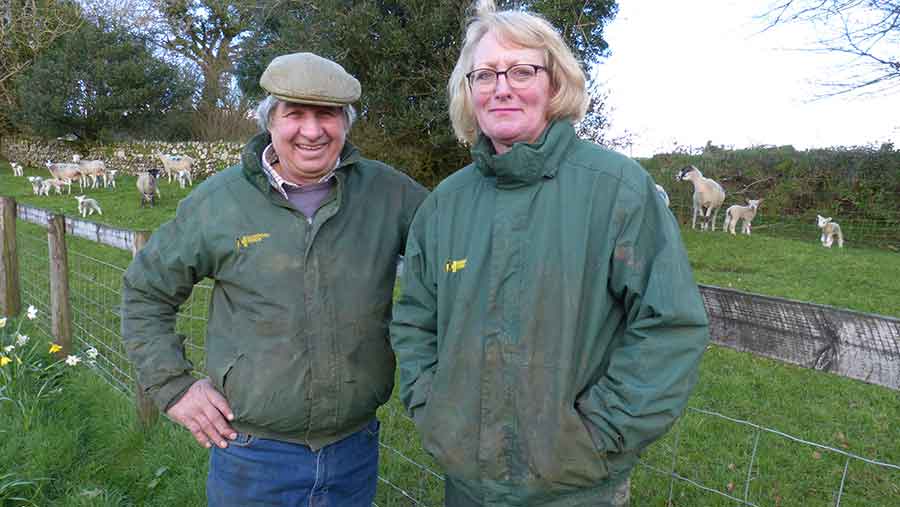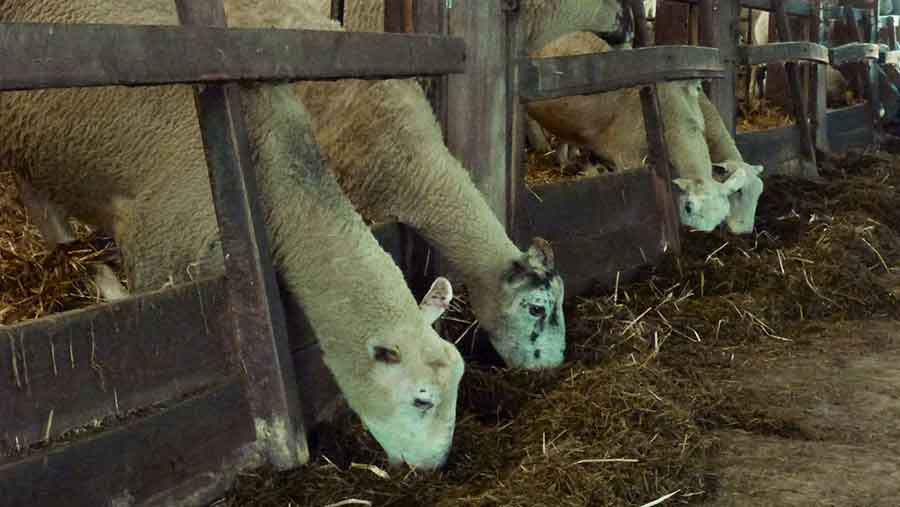Feed plan halves pre-lambing ration costs on Devon farm
Winter feeding costs have halved on a Devon farm using veterinary advice to fine-tune a total mixed ration and feed good-quality silage.
John and Bridget Goscomb have historically been making a high-quality silage at Sindercombe Farm, South Molton, but have only really started seeing big savings in the last three years.

John and Bridget Goscomb
By using the guidance of veterinarian Liz Nabb at Torch Farm Vets they now feed late gestation ewes for three weeks rather than six.
See also: Avoid feeding ewes too much starch in critical pre-lambing period
And by feeding soya and barley in relation to silage quality they have cut cake costs from 28p a ewe a day to 14p a ewe a day.
The amount of ewe nuts bought by the farm has fallen from 20t back in 2008 to 3t so far this winter, explains Mrs Goscomb.
The ration change is monitored by metabolically profiling sheep three weeks before the lambing date.

“This is just used for reassurance really,” says Mrs Goscomb, who runs a mix of Lleyns and North of England Mules over a mixed farm.
Flock facts
- 560 commercial flock of Lleyns and Mules
- Terminal sires used – Performance recorded Charolais and Lleyn rams
- Some females retained to self-replace Lleyns
- Lambs sent to Randall Parker to Sainsbury’s on contract
- Starting to experiment with Abermax and Primera this year
- 20 acres classed as Severely Disadvantaged Area
- 80-90 acres of silaging ground
- 200-acre farm with 100 acres rented
“We tend to take bloods from five twins and five triplets to see how they are feeding on it and if anything can be changed. So far we haven’t needed to alter anything.”
This is a major change from the previous system, which saw cake fed in a “bucket and chuck it” fashion in pens and silage chopped with a Tub-mixer wagon.
Cake is still bought but now only fed to triplets pre-lambing and possibly after to help ewes milk.
This year the 75 ewes on additional cake will cost the farm just shy of £99 for three weeks in addition to the flock costs of £3 a ewe.
Whether ewes are fed cake after lambing is hugely dependent on their condition and grass availability, with nothing fed if ewes can be turned out to the grazing platform with covers of 4-5cm or more.
“We have only bought three tonnes of ewe nuts this year,” explains John.
“It’s the same high-quality cake at 19%CP which the triplets get on top of the ration the singles and twins receive. Triplets get 115g morning and night, so 230g in all.”
|
Silage quality |
Rating |
|
DM |
36.7% |
|
Crude protein |
14.8% |
|
D-value |
67.9% |
|
ME |
10.9MJ/kg |
Rationing ewes

Liz Nabb
Rations are drawn up under the guidance of Liz Nabb, aiming to provide metabolisable protein over and above the AFRC (1993) recommendations for ewes in order to optimise milk production.
All sheep receive up to 2.5% of their bodyweight in dry matter, which is made up of chopped silage, barley, soya and a mineral mix.
“Sheep are around the 70kg mark here. This equates to a total DM intake of 1.4-1.8kg in late pregnancy,” explains Ms Nabb. “The proportion of silage consumed drops in the last three weeks over pregnancy but her DM intake is maintained as rumen efficiency increases.
“This allows us to increase the energy and protein density of the diet and continue to meet her needs.”
Example ration
|
From three weeks pre-lambing (twins) |
From one week pre-lambing (twins) |
|
Forage is 1.7% of bodyweight in DM |
Forage is 1.5% of bodyweight in DM |
|
1.05kg silage |
1.05kg silage |
|
100g barley |
350g barley |
|
100g soya |
100g soya |
Monitoring ewes
Tupping starts on 20 October, with only eight sheep missed after the first cycle last autumn. Usual flock output sees 177% scanning, 162% sold, with 2% of those sold as stores.
Sindercombe silage
- Cut two weeks earlier: late May/early June
- Always ensile grass quickly – within 24 hours after cutting
- Top up silage ground with extra 60 units of N after grazing (100 units in total)
- Extra 60 nitrogen 14 sulphur @£240/t = £1,620
- Invest in innoculant and additive
- Grass mix including Timothy, white clover four perennial ryegrasses
- Ryegrass heading dates 27 May to 4 June
- Soil samples analysed every three years
“I have a good feel of sheep at weaning and tupping,” explains Bridget, who monitors condition closely to avoid thin sheep not milking properly and to help with fertility rates.
Shearing within a week of winter housing at Christmas means observing ewe body condition is made easy. Sheep are shorn once, but the timing is critical to ensuring they eat enough quality silage.
Sheep are fed chopped silage from the wagon until the ration is included three weeks prior to lambing.
At this point blood samples are taken and analysed for beta-hydroxybutyrate (BHB), albumin, urea-nitrogen at the Dairy Herd Health and Productivity (University of Edinburgh) Laboratory.
The standard service, which costs £120+VAT for 20 samples, calls for groups of no less than five sheep in each category (single, twin, triplet).
BHB levels show whether there is enough energy in the diet as these ketones are produced when fat is being excessively mobilised, explains Ms Nabb.
“Ewes will naturally have to use some of their reserves as their requirements increase at the end of pregnancy and into lactation. References say BHB should be below 1mmol/litre for scanned ewes.
“Urea-nitrogen levels show the short-term protein intake and the albumin indicates the long-term protein intake as well as potentially indicating whether there are parasites affecting ewes such as fluke or Haemonchus contortus.”
Rationing service
Torch Farm Vets started a sheep rationing service four years ago. They are seeing a growing number of farmers asking for advice to make cost-effective rations.
“We tend to get involved after scanning. It’s important to know the feeding system, forage availability and ewe condition,” explains Ms Nabb.
Ewes fed a good silage (10-11ME) may not not need supplementary feeding until three to four weeks out, with lamb growth only really starting in the last six to eight weeks pre-lambing.
She adds that udder development happens in the last month of pregnancy, by which point it’s informative to have a metabolic profile taken from blood samples so ration adjustments can be made.
“Two or three weeks pre-lambing is when to test sheep bloods for nutritional purposes. If there is something wrong there is time to put it right. Tweaking it will improve colostrum quality and viable lambs.”
Soya can be a suitable supplement to high-quality silage, being a source of rumen bypass protein (DUP) to the ewe when her metabolisable protein demands are high in late pregnancy.
Likewise, she recommends farmers talk to veterinarians and nutritionists about the difference between metabolisable energy and fermentable metabolisable energy the rumen bugs can use. “There is much more to how a forage or concentrate feeds out than the ME and CP alone.”
Driving intakes
- Silage quality – aim for ME of 10.5-11
- Push up silage 2-3 times a day at the feed trough
- Ration calculated by SAC’s Feedbyte programme
- Winter shearing helps drive intakes
- Chopping silage to 4-5cm increases intakes
- Ensuring 15cm a ewe to access the trough
